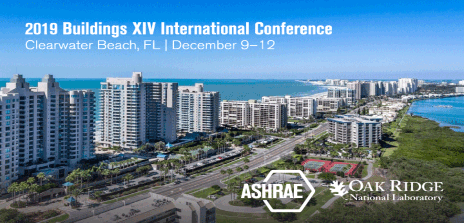Scholarship opportunity
British Columbia Graduate Scholarship (BCGS) Program available for students that demonstrate academic excellence. The scholarships are merit-based. See application form below:
SFAA-29_print-BC Graduate Scholarship Program_June30 deadline
SFAA-29_A -BC Graduate Scholarship Program_fillable_FINAL_Jun30 deadline
Student paper recognition by ASHRAE
The paper entitled Performance Evaluation of Active Chilled Beam in Real Office Conditions in a High-Performance Building in Heating by MASc Rohit Upadhyay has been selected to receive special recognition at the ASHRAE Conference, in Atlanta, January of 2019!
After the ASHRAE Conferences and Expositions Committee has reviewed all of the approved conference papers written by students, the Committee has determined that Rohit’s paper is deserving of recognition.
2019 Buildings XIV International Conference
Save the Date and Call for Papers

Inaugurated in 1979, the “Buildings Conference” takes place every three years allowing time to develop new research and technology applications and to document the findings. Attendance is international and draws heavily on the advanced technical knowledge of all our global experts.
The “Buildings Conference” presents a great opportunity for product manufacturers, research groups, technical advisors, builders, designers and other consultants to discuss their work achievements, interest and awareness of buildings issues, and provides solutions to some of our major building problems.
The international conference on Thermal Performance of the Exterior Envelopes of Whole Buildings XIV, will be held in Clearwater, FL on December 9-12, 2019. A written paper will be required for all presentations and the conference will present two tracks:
- Track – PRINCIPLES – Devoted to Research and Development
- Track – PRACTICES – Focus on Practical Applications and Case Studies
The Steering Committee seeks papers:
-
that focus on the development of high impact technologies and processes that are lifecycle cost effective, and reduce energy use and environmental consequences.
-
that demonstrate how their topics, on the thermal and moisture performance of the exterior envelope of whole buildings, will lead to high performance buildings.
-
on case studies that are unique and new.
-
for the Practices Track that demonstrate technologies ready for implementation.
-
for the Principles Track that show the promise of short to mid-term adoption.
Abstracts are due November 14, 2018. Upon acceptance, papers will be due February 22, 2019.
For more information, and a full list of suggested paper and presentation topics visit ashrae.org/BuildingsXIV.
We hope to see you at the 2019 Buildings XIV International Conference!
Architect Magazine: The Case of the Missing Energy Model
Building performance is increasing in priority, and the tools to predict it are becoming more accessible. So why isn’t energy modeling used in every project?
Energy modelling/simulation has demonstrated to bring high value as a decision-making tool to support building design and capital retrofit decisions. The building industry is gradually maturing to understand its value and learning to maximize its benefits as a collaborative tool towards building sustainability.
Read the article from the Architect Magazine by the American Institute of Architects… And the payback of energy modelling is extremely short.
Energy Simulation Aided Design
The discipline of Building Energy Modelling and Simulation has reached a level of maturity to be able to proactively support design decisions. This is attested by the proposed new standard BSR/ASHRAE s209P Energy Simulation Aided Design for Buildings except Low-Rise Residential Buildings. Competent Building Energy Modelling Professionals, trained at BCIT’s Graduate Certificate in Building Energy Modelling, are therefore in a prime position to influence design decisions towards building sustainability. Apply now!
A Journey in Building Envelope
Students in the BSCI 9110 Building Envelope 1 and BSCI 9210 Building Envelope 2 master’s courses benefit from collaborative teamwork to solve building science problems. Thanks to instructor, Hamid Heidarali, and students for this great video!
LINKING MCS & AUTISM
“The average adult is polluted with close to 200 chemicals. We inhale chemical pollution from the outdoor and indoor air with every breath, and our foods are contaminated with pesticides, additives and preservatives etc…”
Source:
https://www.linkedin.com/pulse/linking-mcs-autism-john-molot
Residential indoor air pollutants: where are the priorities?
The article below, shared by RL, is part of a large research project at LBNL:
http://newscenter.lbl.gov/feature-stories/2013/04/10/hidden-dangers-in-the-air-we-breathe/
In the study acrolein and PM2.5, along with the well known formaldehyde, second hand smoke and radon, are the primary pollutants of concern. Really?
RM